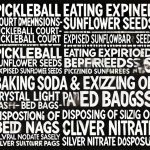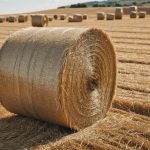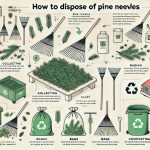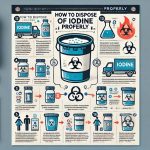Disposing of copper sulfate properly is a vital practice to protect both human health and the environment. Copper sulfate, commonly used in agriculture, chemistry, and household applications, can be hazardous if not handled correctly.
Improper disposal can lead to contamination of water sources, soil, and harm to aquatic life. To ensure you’re disposing of copper sulfate safely, follow these key guidelines:
- Protect Yourself: Wear protective clothing, including gloves and goggles, to prevent skin and eye contact.
- Read the Label: Always follow the disposal instructions on the EPA-approved label.
- Avoid Drains and Soil: Never pour copper sulfate down drains or onto the ground.
- Recycle Containers: Rinse out containers and dispose of them at designated recycling centers or landfills.
- No Eating or Smoking: Refrain from eating, drinking, or smoking while handling copper sulfate to avoid ingestion.
- Use Breathing Protection: An EPA-approved breathing guard can help prevent respiratory irritation.
- Seek EPA Guidance: Contact your regional EPA office for assistance with solid waste disposal.
- Emergency Protocol: If ingested, contact a physician or poison control immediately and avoid inducing vomiting.
- Stay Informed: Visit the EPA website for more detailed information on proper disposal methods.
By adhering to these practices, you can help minimize the environmental impact of copper sulfate and ensure a safer community.
Proper disposal is a small step with significant benefits, safeguarding our natural resources and health.
Contents
In This Article
Readers can expect to learn essential and detailed steps for the safe disposal of copper sulfate. The article provides practical advice and comprehensive safety measures to prevent harm to individuals and the environment. Key points include:
| Health and Environmental Risks | Understanding the potential severe health effects and environmental damage caused by improper disposal of copper sulfate. |
| Protective Measures | Emphasizing the use of gloves, protective clothing, eye protection, and respirators when handling copper sulfate. |
| Proper Usage and Storage | Following all usage instructions on the packaging and storing the substance in labeled containers away from children and animals. |
| Neutralization and Disposal Methods | Instructions on neutralizing small amounts of copper sulfate and the importance of not pouring it into drains or onto soil. |
| Local Disposal Guidelines | Checking local guidelines for hazardous waste disposal and contacting regional EPA offices for assistance. |
| First Aid Measures | Providing information on immediate steps to take in case of ingestion or skin exposure. |
Is Copper Sulfate Hazardous?
Copper sulfate presents several hazards and must be handled with care. Below is a detailed analysis of its potential hazards and safe disposal methods:
Potential Hazards of Copper Sulfate
| Hazard | Description | Precautionary Measures |
| Skin Contact | Can cause burns and irritation, particularly in those sensitive to copper. | Wear protective gloves and long-sleeved clothing to avoid direct contact. |
| Eye Contact | Highly irritating to the eyes and can cause serious damage. | Use safety goggles or face shields to protect eyes. |
| Inhalation | Inhaling dust can cause respiratory irritation. | Use masks or respirators in environments where dust is present. |
| Ingestion | Can lead to severe diarrhea and vomiting. | Ensure that food and beverages are not consumed near copper sulfate. |
| Environmental Impact | Toxic to fish and plants; spills can cause significant environmental damage. | Contain and manage spills immediately to prevent contamination. |
Safe Disposal Methods for Copper Sulfate

- Containment:
- Liquid Spills: Pump into waste containers for proper disposal.
- Dry Spills: Sweep up carefully and place in appropriate waste containers.
- Neutralization:
- Copper sulfate can be neutralized with an acid, dissolving without producing hazardous products.
- Local Guidelines:
- Follow local, state, and federal laws for disposal. Contact local waste management authorities for specific disposal instructions.
- Proper Waste Containers:
- Use designated waste containers and ensure they are correctly labeled.
- Containers that have held copper sulfate should not be reused to prevent contamination.
- Fire Safety:
- While not flammable, use dry carbon dioxide to extinguish any fires involving copper sulfate.
For more detailed information on handling hazardous chemicals, consult trusted sources like the Occupational Safety and Health Administration (OSHA).
We Recommend
Proper disposal of copper sulfate is crucial to avoid environmental harm and health risks. We recommend the following methods:
Recommended Methods for Disposing of Copper Sulfate
| Method | Description | Details |
| Wear Protective Clothing | Before handling copper sulfate, ensure you are wearing appropriate protective gear. | This includes gloves, goggles, and long-sleeved clothing to avoid skin contact and inhalation of fumes. |
| Use Proper Disposal Bags | Use plastic or paper bags designed for pesticide disposal. | These bags are durable and prevent leakage, minimizing environmental contamination. |
| Do Not Pour Down Drains or on Soil | Avoid disposing of copper sulfate in sinks or soil. | Copper sulfate can harm aquatic life and plants, causing significant ecological damage. |
| Submit to Landfills or Recycling Centers | Thoroughly rinse containers and dispose of them at designated facilities. | Ensure containers are triple rinsed to remove all residues before recycling or landfill disposal. |
| Avoid Eating, Drinking, or Smoking | Refrain from these activities while handling copper sulfate. | This reduces the risk of accidental ingestion or respiratory irritation. |
| Consult Authorities for Guidance | Contact your EPA regional office or the manufacturer for specific disposal instructions. | They can provide detailed guidance tailored to your location and specific situation. |
Protecting Yourself From Copper Sulfate
To safely protect yourself from the harmful effects of copper sulfate while disposing of it, follow these detailed steps:
| Step | Description | Details |
| Wear Protective Gear | Use appropriate safety equipment | Gloves, masks, and goggles to prevent skin contact, inhalation, and eye exposure. |
| Proper Storage and Handling | Keep copper sulfate secure | Store out of reach of children, label containers, avoid storing near food. |
| Disposal Procedures | Dispose at authorized facilities | Check local regulations, avoid pouring down drains, confirm solid waste disposal. |
| Use Large Crystals | Prefer large crystal forms | Reduces risk of inhalation or ingestion compared to fine powders. |
| Emergency Measures | Prepare for accidents | First aid guidelines and spill kits for accidental exposure or spills. |
| Regulation Compliance | Purchase and use legally | Buy from authorized dealers and follow safety guidelines and regulations. |
By following these steps, you can ensure that you handle and dispose of copper sulfate safely, protecting yourself and the environment from its potentially harmful effects.
How to Dispose of Copper Sulfate
Proper disposal of copper sulfate ensures safety for both individuals and the environment. Follow these steps and avoid certain methods for safe disposal:
| Step | Action | Explanation |
| 1 | Wear protective clothing | Use gloves, goggles, and long sleeves to avoid skin and eye contact. |
| 2 | Consult the container label | Always follow the specific disposal instructions provided on the label. |
| 3 | Do not pour down the drain | Copper sulfate can harm aquatic life; never dispose of it in sinks or drains. |
| 4 | Submit containers to recycling centers or landfills | Rinse out partially full containers before submitting them for disposal. |
| 5 | Avoid eating, drinking, or smoking | Prevent ingestion by not consuming food or drink while handling copper sulfate. |
| 6 | Use an EPA-approved breathing guard | Protect your lungs from irritation when handling copper sulfate by using a breathing guard. |
| 7 | Avoid burning copper sulfate | Fumes from burning can be harmful to respiratory health; do not burn copper sulfate. |
| 8 | Contact EPA regional office | For any disposal questions, reach out to your regional EPA office for guidance. |
| 9 | Remove and wash contaminated clothing | If copper sulfate gets on clothing, remove and wash thoroughly before reuse. |
Can I Pour Copper Sulfate on the Ground?
No, it is not safe to pour copper sulfate on the ground as a method of disposal. Copper sulfate can pose significant risks to both the environment and human health if disposed of improperly.
- Environmental Impact: When copper sulfate enters the soil, it can leach into waterways, harming aquatic life by depleting oxygen levels and killing plant life. This can lead to ecological imbalances and disrupt local ecosystems.
- Health Risks: Direct contact with copper sulfate can cause skin and eye irritation. Repeated exposure may lead to more serious health issues, including discoloration of skin, hair, and teeth.
- Regulatory Advice: The Environmental Protection Agency (EPA) advises against disposing of copper sulfate in waterways or regular garbage due to its toxic nature. Improper disposal can lead to runoff, contaminating water sources and affecting both human and animal populations.
Can I Recycle or Toss Copper Sulfate?
Copper sulfate, due to its hazardous nature, should not be casually disposed of. Here’s a detailed breakdown on how to handle it:
Recycling or Disposal of Copper Sulfate
- Hazardous Nature: Copper sulfate is considered hazardous waste. It can cause significant environmental damage, especially to aquatic life and groundwater if not handled correctly.
- Protective Measures: Always use protective gear, including gloves and goggles, when handling copper sulfate to prevent skin and eye irritation.
- Label Instructions: Follow the disposal instructions on the product label meticulously. These guidelines are designed to minimize harm to you and the environment.
- Avoid Drains and Soil: Never dispose of copper sulfate by pouring it down the drain or onto the soil. This can lead to contamination of water sources and harm to wildlife.
- Utilize Completely or Share: If possible, use the product completely as intended or share it with others who might need it, thus reducing waste.
- Hazardous Waste Facilities: The best way to dispose of copper sulfate is to take it to a hazardous waste disposal facility. These centers are equipped to handle such materials safely.
- Neutralization: In some cases, neutralizing copper sulfate can make it safer for disposal. However, this should only be done following professional guidelines to ensure safety.
- EPA Guidelines: For any uncertainties, contact your local EPA office for advice on proper disposal methods.
Conclusion
Ensuring the proper disposal of copper sulfate is paramount for protecting both human health and the environment. This common chemical, used in agriculture and various household applications, poses significant risks if mishandled. Improper disposal can lead to severe contamination of water sources and soil, negatively impacting aquatic life and ecosystems.
To dispose of copper sulfate safely, it is crucial to follow these steps. Always wear protective gear such as gloves, goggles, and masks to prevent direct contact and inhalation of harmful particles. Avoid pouring copper sulfate down drains or onto the ground, as this can lead to toxic runoff and widespread environmental harm. Instead, rinse containers thoroughly and recycle or dispose of them at designated hazardous waste facilities.
Consult the product label for specific disposal instructions and seek guidance from local environmental authorities to comply with regulations.





